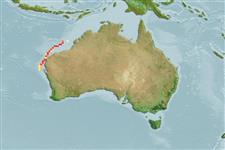Teleostei (teleosts) >
Gadiformes (Cods) >
Macrouridae (Grenadiers or rattails)
Etymology: Coelorinchus: Greek, koilos = a hollow + Greek, rhyngchos = jaw (Ref. 45335); charius: Specific name from the Greek word 'charieis' meaning graceful.
More on authors: Iwamoto & Williams.
Environment: milieu / climate zone / depth range / distribution range
Ecology
Marine; bathydemersal; depth range 420 - 691 m (Ref. 35909). Deep-water; 17°S - 26°S
Eastern Indian Ocean: known only from Western Australia, Australia.
Size / Weight / Age
Maturity: Lm ? range ? - ? cm
Max length : 37.0 cm TL male/unsexed; (Ref. 35909)
Dorsal spines (total): 2. The snout moderate in adults to long in young, sharply pointed, 38-50% of head length (HL), anterolateral margin completely supported by bone Orbit diameter less than postorbital length of head, 24-30% HL, 1.3 - 2.1 times into snout length. The upper jaw extending posteriorly to below hind margin of pupil. Short, narrow, pointed flap of subopercle. Short, naked black fossa of light organ anterior to anus, with the anus removed from anal fin by one or two scale rows. Underside of head with small, finely spinulated scales except along the border of the mouth, ventral and posterior margins of preopercle, and anteriorly on lower jaw. Scattered scales on nasal fossa, mostly confined ventrally. Body scales with short overlapping spinules in 4-7 divergent rows, none especially broad-based nor enlarged. Fins without prominent markings (Ref. 35909).
Found on the continental slope. Benthic (Ref. 75154).
Life cycle and mating behavior
Maturity | Reproduction | Spawning | Eggs | Fecundity | Larvae
Iwamoto, T. and A. Williams, 1999. Grenadiers (Pisces, Gadiformes) from the continental slope of western and northwestern Australia. Proc. Calif. Acad. Sci. 51(3):105-243. (Ref. 35909)
IUCN Red List Status (Ref. 130435: Version 2024-2)
Threat to humans
Harmless
Human uses
Fisheries: of potential interest
Tools
Special reports
Download XML
Internet sources
Estimates based on models
Preferred temperature (Ref.
123201): 6.8 - 10.6, mean 8.3 °C (based on 6 cells).
Phylogenetic diversity index (Ref.
82804): PD
50 = 0.5000 [Uniqueness, from 0.5 = low to 2.0 = high].
Bayesian length-weight: a=0.00102 (0.00046 - 0.00225), b=3.06 (2.88 - 3.24), in cm total length, based on all LWR estimates for this body shape (Ref.
93245).
Trophic level (Ref.
69278): 3.5 ±0.5 se; based on size and trophs of closest relatives
Resilience (Ref.
120179): Low, minimum population doubling time 4.5 - 14 years (Preliminary K or Fecundity.).
Fishing Vulnerability (Ref.
59153): Low to moderate vulnerability (27 of 100).
